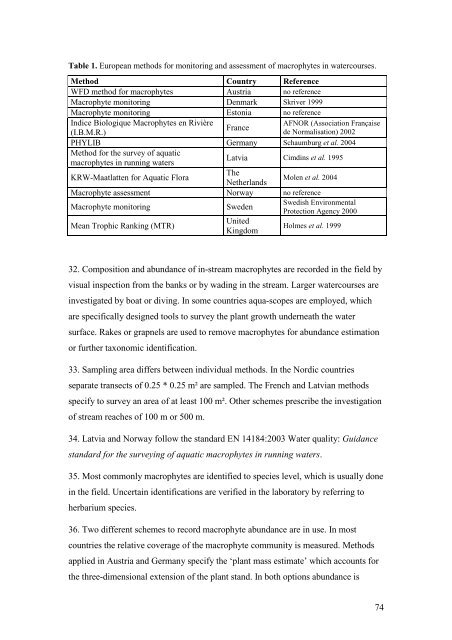Report on Harmonisation of freshwater biological methods
Report on Harmonisation of freshwater biological methods
Report on Harmonisation of freshwater biological methods
You also want an ePaper? Increase the reach of your titles
YUMPU automatically turns print PDFs into web optimized ePapers that Google loves.
Table 1. European <strong>methods</strong> for m<strong>on</strong>itoring and assessment <strong>of</strong> macrophytes in watercourses.Method Country ReferenceWFD method for macrophytes Austria no referenceMacrophyte m<strong>on</strong>itoring Denmark Skriver 1999Macrophyte m<strong>on</strong>itoring Est<strong>on</strong>ia no referenceIndice Biologique Macrophytes en RivièreAFNOR (Associati<strong>on</strong> FrançaiseFrance(I.B.M.R.)de Normalisati<strong>on</strong>) 2002PHYLIB Germany Schaumburg et al. 2004Method for the survey <strong>of</strong> aquaticmacrophytes in running watersLatvia Cimdins et al. 1995KRW-Maatlatten for Aquatic FloraTheNetherlandsMolen et al. 2004Macrophyte assessment Norway no referenceMacrophyte m<strong>on</strong>itoringMean Trophic Ranking (MTR)SwedenUnitedKingdomSwedish Envir<strong>on</strong>mentalProtecti<strong>on</strong> Agency 2000Holmes et al. 199932. Compositi<strong>on</strong> and abundance <strong>of</strong> in-stream macrophytes are recorded in the field byvisual inspecti<strong>on</strong> from the banks or by wading in the stream. Larger watercourses areinvestigated by boat or diving. In some countries aqua-scopes are employed, whichare specifically designed tools to survey the plant growth underneath the watersurface. Rakes or grapnels are used to remove macrophytes for abundance estimati<strong>on</strong>or further tax<strong>on</strong>omic identificati<strong>on</strong>.33. Sampling area differs between individual <strong>methods</strong>. In the Nordic countriesseparate transects <strong>of</strong> 0.25 * 0.25 m² are sampled. The French and Latvian <strong>methods</strong>specify to survey an area <strong>of</strong> at least 100 m². Other schemes prescribe the investigati<strong>on</strong><strong>of</strong> stream reaches <strong>of</strong> 100 m or 500 m.34. Latvia and Norway follow the standard EN 14184:2003 Water quality: Guidancestandard for the surveying <strong>of</strong> aquatic macrophytes in running waters.35. Most comm<strong>on</strong>ly macrophytes are identified to species level, which is usually d<strong>on</strong>ein the field. Uncertain identificati<strong>on</strong>s are verified in the laboratory by referring toherbarium species.36. Two different schemes to record macrophyte abundance are in use. In mostcountries the relative coverage <strong>of</strong> the macrophyte community is measured. Methodsapplied in Austria and Germany specify the ‘plant mass estimate’ which accounts forthe three-dimensi<strong>on</strong>al extensi<strong>on</strong> <strong>of</strong> the plant stand. In both opti<strong>on</strong>s abundance is74














![Accommodation booking form [PDF]](https://img.yumpu.com/39471785/1/184x260/accommodation-booking-form-pdf.jpg?quality=85)

